| Title | Image | Page Summary: |
|---|---|---|
| dePas - The First Part | ||
| dePas - First Part - Page 1 |
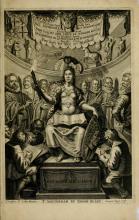
|
The image includes inscriptions in multiple languages promoting the first part of a work on painting and drawing with an emphasis on the study of light. It was produced by Jodan Blaeu in Amsterdam and highlights various artistic principles across languages. The central theme is a celebration of artistic knowledge and technique, focusing on the representation of light in art. |
| dePas - First Part - Page 2 |
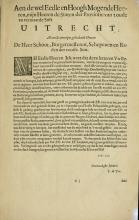
|
The text is a formal address to the Lords of Utrecht, showing gratitude and humility. It explains that the author wishes to dedicate a small work to them, acknowledging their support and expressing hope for future opportunities. The author also focuses on providing education and art to the common people, especially children, without much cost. |
| dePas - First Part - Page 3 |

|
The text praises the art of drawing for its excellence and utility, emphasizing its role as the foundation for many sciences. It describes how drawing is essential for various mechanical arts and painting. The author notes that while art is highly valued, errors are common among contemporary practitioners and emphasizes the need to explore new ideas to clarify and improve the understanding of art. |
| dePas - First Part - Page 4 |

|
Crispijn de Pas describes his lifelong dedication to the arts and learning. He addresses readers who appreciate drawing and offers insights into his methods and teachings. The text highlights his service to noble patrons and his aim to share knowledge of art and drawing. |
| dePas - First Part - Page 5 |
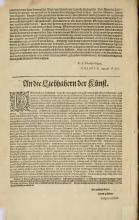
|
The text emphasizes the esteemed status of drawing as an art form, appreciated for its usefulness and noble heritage. It was respected among high societies and necessary for architectural practices. The art of drawing was seen as a duty among the nobility and was integral to cultural history. |
| dePas - First Part - Page 6 |
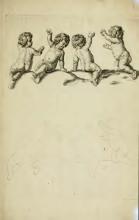
|
|
| dePas - First Part - Page 7 |
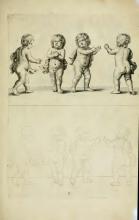
|
The page contains a numeral 'II' and features artistic representations of cherubic figures. The top half shows completed illustrations while the bottom half provides dotted outlines for instructional purposes. |
| dePas - First Part - Page 8 |
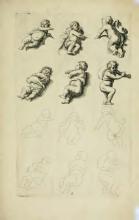
|
The page mainly contains artistic illustrations of cherub-like figures with minimal text. It does not include much textual content except for the small number '3' at the bottom. The illustrations likely serve as examples or exercises in drawing these figures. |
| dePas - First Part - Page 9 |
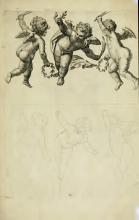
|
The image features page number IV with cherubic figures depicted in classical style. The top shows detailed figures, while the bottom offers outlines as a drawing guide. |
| dePas - First Part - Page 10 |
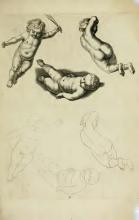
|
The text indicates that the image is labeled "Plate V" from a historic art book. The book provides instructional illustrations for drawing human anatomy. The image shows cherubic figures in various poses, aiding in the study of human form and movement in art. |
| dePas - First Part - Page 11 |
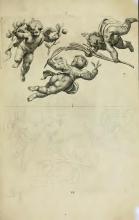
|
The page features the Roman numeral VI, indicating the page number. It contains no additional text, focusing primarily on the illustrations. |
| dePas - First Part - Page 12 |
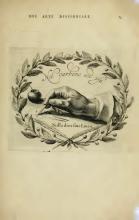
|
The text includes two Latin phrases central to artistic practice: "Nothing by charcoal but by use," highlighting practice's value, and "No day without a line," stressing the importance of daily drawing. These emphasize the dedication required for mastery in art. |
| dePas - First Part - Page 13 |
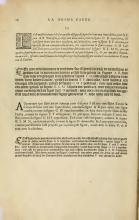
|
The text provides guidance on drawing different basic geometric shapes as the foundation for more complex drawing concepts. It emphasizes learning to draw straight and curved lines, triangles, squares, circles, and ovals. The instructions are meant to help artists develop skills in sketching anatomy with charcoal. |
| dePas - First Part - Page 14 |
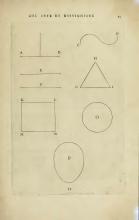
|
The text is the title of the page: 'On the Art of Drawing'. It suggests that this page is related to drawing techniques. The geometric illustrations support this, as they are typical foundational elements for artists. |
| dePas - First Part - Page 15 |
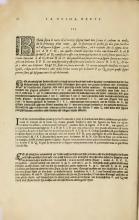
|
The text provides guidance for beginners on holding charcoal steadily to ensure precision in drawing. It explains a step-by-step method to draw geometric shapes, such as squares, triangles, and ovals, using marked letters as guides. This technique is suggested to enable the drawing of any figure in the world. |
| dePas - First Part - Page 16 |
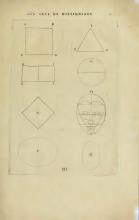
|
The extracted text consists mainly of geometric labels which likely correspond to the shapes in the image. It is part of a guide on the art of drawing, specifically focusing on foundational elements like geometric shapes and proportions. |
| dePas - First Part - Page 17 |
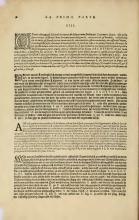
|
The text provides instructions for sketching the human head by dividing it into four equal parts using a grid method. Starting with an oval shape, it details how to partition it accurately to map out features like eyes, nose, and hairline. This method offers a foundational approach to understanding human proportion in art, aiding artists in creating realistic representations. |
| dePas - First Part - Page 18 |
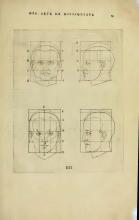
|
The text at the top translates to 'On the Art of Drawing,' indicating the content focuses on methods or principles related to drawing. |
| dePas - First Part - Page 19 |
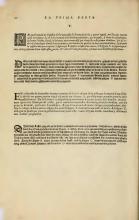
|
The text demonstrates a method to draw a face head-on, divided into four equal parts using an oval as a guide. It outlines the placement of facial features like eyes, nose, and mouth and explains the use of perpendicular lines to maintain proportions. Various figures illustrate different types of faces, including a young face and an older one, with a focus on maintaining the same proportions. |
| dePas - First Part - Page 20 |
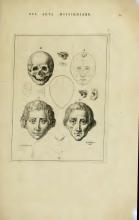
|
The title of the page translates to 'Of the Art of Drawing'. It doesn't contain more detailed text within the image itself. |
| dePas - First Part - Page 21 |

|
The text discusses how to depict the eye, which is a principal part of the face, using simple geometric shapes. It explains dividing an oval into equal parts and describes forming the eye's profile using a triangle and circle to guide the drawing. The guide also illustrates the proportions for the upper and lower lips using specific geometric representations. |
| dePas - First Part - Page 22 |
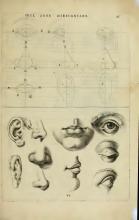
|
The page features diagrams and illustrations focused on teaching the drawing of facial features. It includes geometric layouts and labeled parts, enhancing the educational value of the illustrations for artists. |
| dePas - First Part - Page 23 |
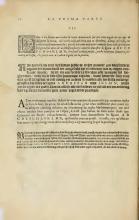
|
The text outlines a method for drawing the face using simple sketches rather than complex mathematical rules. It emphasizes the importance of practice in capturing the profile of facial features such as the eyes, nose, and mouth. The figures A to N illustrate these concepts, showing that drawing relies on changes in perspective rather than strictly defined rules. |
| dePas - First Part - Page 24 |
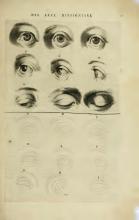
|
The text in the image translates to 'The Art of Drawing.' The page includes instructional images of eyes, with both detailed illustrations and simplified line diagrams for artists. |
| dePas - First Part - Page 25 |
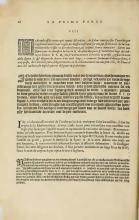
|
The text provides instructions for drawing ears and eyes using a simpler method, improving upon previous mathematical guidelines. It explains how to create a figure divided into two parts and use lines to find the right positions in profile. The process involves drawing with charcoal and perfecting details with a pen. |
| dePas - First Part - Page 26 |
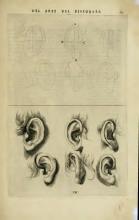
|
The page is titled "The Art of Drawing" and includes text labeling focal points in ear illustrations. It is part of an instructional work on art techniques, specifically focusing on drawing the human ear. |
| dePas - First Part - Page 27 |
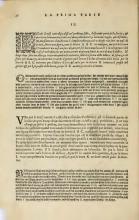
|
The text describes how to draw a nose and mouth using simple geometric shapes. It provides instructions on drawing the nose and mouth, starting from a front view and using letters as guides for different parts of the face. This helps in visualizing and constructing the features accurately. |
| dePas - First Part - Page 28 |
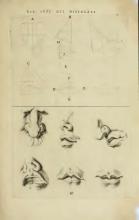
|
The text is titled "The Art of Drawing" and includes labeled diagrams and illustrations. The drawings provide guidance on creating facial features, including the nose and mouth. The content is likely instructional, aimed at teaching artistic techniques for rendering human expressions. |
| dePas - First Part - Page 29 |
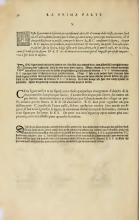
|
The text explains the technique of drawing faces in profile, focusing on the shifting of lines and the correct measures necessary for accurate representation. Using letters A B C and D E F, it provides examples of how to observe proportions for different details such as the nose and mouth. It highlights the importance of understanding how different angles impact the depiction of a face. |
| dePas - First Part - Page 30 |
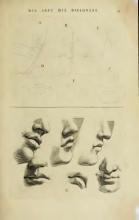
|
The page is titled 'On the Art of Drawing' and includes alphabetical labels for guidelines. It features a series of detailed drawings illustrating facial profiles. The page serves both as an instructional guide and demonstration of artistic techniques. |
| dePas - First Part - Page 31 |
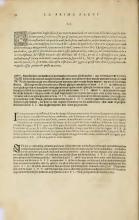
|
The text discusses simplifying the understanding of facial proportions using an oval shape, as illustrated by letters and curved lines. It describes how features like the eye and face align with these guidelines. These instructions aim to depict the variation and true size of features as perceived, noting changes using different line techniques. |
| dePas - First Part - Page 32 |
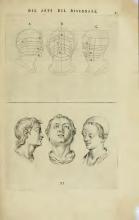
|
The text and images are from a book on drawing, demonstrating methods to sketch heads. It includes diagrams marked with letters to guide artists and sketches illustrating different views of a head. The title suggests this section focuses on techniques in drawing art. |
| dePas - First Part - Page 33 |
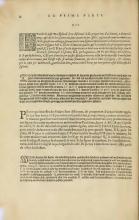
|
The text provides a method for drawing children's heads. It describes the use of a square, divided into four parts, to precisely position facial features. Instructions cover the placement of the forehead, cheeks, nose, mouth, and chin in profile view, addressing how to adapt the shapes as lines curve and rise. |
| dePas - First Part - Page 34 |
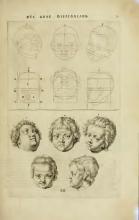
|
The text translates to 'On the Art of Drawing' and the page number 32. The page is part of an instructional guide focusing on the techniques of drawing human heads using proportions. |
| dePas - First Part - Page 35 |
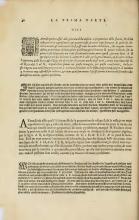
|
The text discusses the geometric proportions of the face and head, using four outlined skull diagrams to illustrate consistency in structure. It explains the use of ovals and lines to achieve these proportions, emphasizing symmetry in drawing facial features. Techniques are offered for maintaining consistent proportions across different views. |
| dePas - First Part - Page 36 |
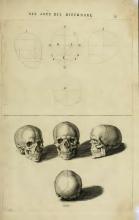
|
The image features text about drawing techniques, focusing on the art of sketching heads and skulls. It includes proportion guidelines and an exploration of head anatomy through labeled diagrams and realistic illustrations. The page is part of a historic book on painting and drawing, published in the 17th century. |
| dePas - First Part - Page 37 |
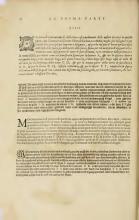
|
The text outlines a basic method for learning to draw, focusing specifically on rendering the hands. The author provides an introductory explanation of proportions and measurements, using letters and geometric shapes such as squares and ovals to aid in understanding. This is a preliminary section with more detailed instruction to follow in a subsequent book. |
| dePas - First Part - Page 38 |
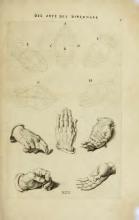
|
The text includes a heading "Of the Art of Drawing" and letters labeling various images. The images likely serve as instructional aids in a historical art book, demonstrating techniques for drawing hands. |
| dePas - First Part - Page 39 |
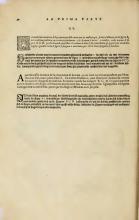
|
The text in four languages (Italian, Dutch, French, and German) describes the proportions and sketching of hands. It explains that figure A and figures B, C, D show how hands turn and fingers form without much difficulty once charcoal is erased. The fingers can easily be placed in a square, and the text notes that sometimes figures change in length as fingers flex or extend. |
| dePas - First Part - Page 40 |
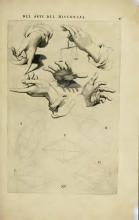
|
The text, which translates to 'On the Art of Drawing,' indicates a focus on techniques in drawing. The accompanying images highlight detailed illustrations of hands and diagrams, serving as instructional aids within the context of artistic anatomy. |
| dePas - First Part - Page 41 |

|
The text discusses a simpler method of portraying hands through four approaches, described in different languages. It highlights the use of diamond or rhomboid shapes to make accurate depictions more accessible. This method is suggested as the easiest way to effectively depict hands in art. |
| dePas - First Part - Page 42 |
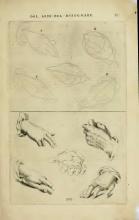
|
The text is a title and labels for diagrams on drawing techniques. It appears to describe an instruction part of a publication focused on the art of drawing, particularly hands. The images illustrate steps from basic shapes to detailed hand drawings. |
| dePas - First Part - Page 43 |
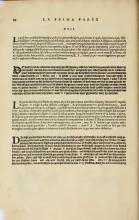
|
The page discusses the difficulty of drawing the feet, particularly of women, and presents an easy method involving geometric shapes like triangles and squares to simplify the drawing process. It describes how to use these shapes to accurately construct the feet and position them correctly. The method is part of a larger discussion that will be elaborated in subsequent problems in the text. |
| dePas - First Part - Page 44 |
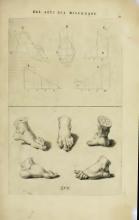
|
The text is titled "On the Art of Drawing" and includes labels A to F associated with the diagrams on the page. It denotes this as page XVII from a historic book on drawing techniques. |
| dePas - First Part - Page 45 |
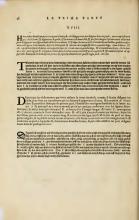
|
The text demonstrates the method for drawing feet using geometric figures, ensuring proportion and accuracy. Foot shapes are broken down into simple forms like circles and triangles to better understand and represent them in art. The instructions emphasize that understanding these fundamental shapes allows one to accurately depict any type of foot desired. |
| dePas - First Part - Page 46 |
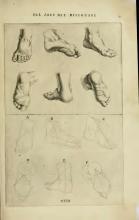
|
The text translates to "On the Art of Drawing," and the page is part of a book that demonstrates methods for drawing the human body, specifically focusing on feet in this instance. The images show both realistic and geometric illustrations to aid artists in understanding form and proportion. |
| dePas - First Part - Page 47 |
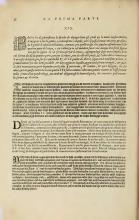
|
The text provides step-by-step instructions on how to draw legs and feet as part of composing a human body. The explanation emphasizes proportions, shapes, and balancing, with references to techniques for sketching and combining elements to form a body. It includes detailed instructions for creating a figure by starting with the legs, described as vital structural elements of the human figure. |
| dePas - First Part - Page 48 |
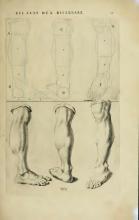
|
The page focuses on the art of drawing, specifically illustrating guidelines and proportions for sketching legs. It combines schematic and realistic depictions, providing a resource for artists to understand leg anatomy and proportions. |
| dePas - First Part - Page 49 |
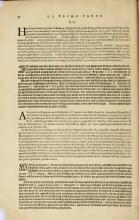
|
The text demonstrates a method to accurately draw legs and feet using a pen after initially sketching with charcoal. It explains the anatomical principles needed to understand muscles, using a past problem as a reference for further illustration. The method involves shading techniques and pen strokes for effective hatching and highlighting. |
| dePas - First Part - Page 50 |
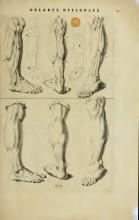
|
The text at the top of the page translates to 'The Art of Design.' It appears to be part of a book discussing artistic techniques related to capturing human anatomy, specifically the lower limbs. |
| dePas - First Part - Page 51 |
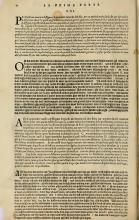
|
The text instructs on how to draw women's and men's feet, highlighting differences with easy steps. It describes dividing the feet into parts for accurate depiction, focusing on drawing techniques related to curves and shadows. Special attention is given to illustrating feet with gentle lines and forming shadows effectively. |
| dePas - First Part - Page 52 |
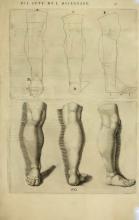
|
The page is titled 'On the Art of Drawing' and includes several letters and numbers likely used to reference parts of the illustrations. It appears to be a guide on drawing proportions and structures of human legs, with reference to specific sketches seen on this page. |
| dePas - First Part - Page 53 |
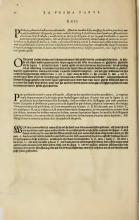
|
The text provides a detailed method for drawing the human arm, emphasizing its necessity and utility. It instructs on dividing the arm into four parts for accurate representation, offering guidance on muscle formation and detailing changes by contrasting two illustrative arms. The importance of careful sketching and shading, previously discussed in relation to legs and feet, is reiterated. |
| dePas - First Part - Page 54 |
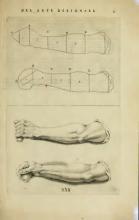
|
The text titled "THE ART OF DRAWING" contains labels and numbered sections likely intended for instructional drawing purposes. It appears to be part of an educational resource for learning how to accurately draw human anatomy, accompanied by detailed sketches and measurements. The diagrams focus on the structure and proportions of the arm. |
| dePas - First Part - Page 55 |
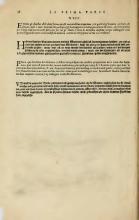
|
The text discusses the proportional similarities between the arms of women and men, noting that women's arms are softer and less muscular. It suggests using a gentler shading technique for women's arms, consistent with the instructions given in a previous problem. The text promises further exploration of these ideas in a subsequent section. |
| dePas - First Part - Page 56 |
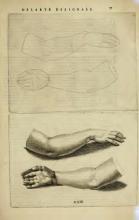
|
The page is titled 'From the Art of Designing' and marked with the numeral twenty-three. It contains illustrations of arms for artistic study and practice. |
| dePas - First Part - Page 57 |
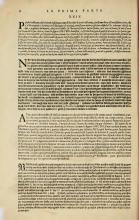
|
The text details how to break down and depict the human body for aspiring artists by dividing it into three main parts: chest, navel, and lower body. It provides instructions on measuring and drawing different body parts such as the shoulders, hips, and profile views. These divisions help artists simplify the process of rendering the body, with guides to reflect different figures and facilitate learning. |
| dePas - First Part - Page 58 |
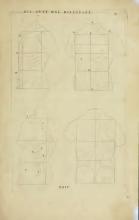
|
The text at the top of the page translates as "Of the Art of Drawing." It appears to be a reference or title to what the instructional images below are about. The number at the bottom is '24,' likely indicating a page or section number. |
| dePas - First Part - Page 59 |
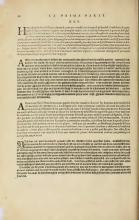
|
The passage details the process of sketching and shading important anatomical features, paying attention to muscles and structure before moving on to detailed shadow work. It emphasizes the gentle application of drawing mediums to preserve initial outlines and create realistic depth. The text offers insight into a 17th-century technique for depicting the human form with precision and artful shading. |
| dePas - First Part - Page 60 |
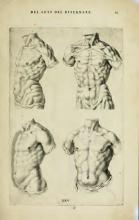
|
The image text, in Italian, translates to "Of the Art of Drawing." The number "XXV" likely refers to a page or plate number, implying a series of anatomical drawings. |
| dePas - First Part - Page 61 |
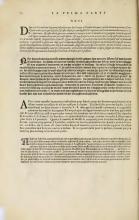
|
The text explains how to construct drawings of the human body, first from the front, then from the back. It provides instructions using labeled sections: shoulders, ribs, thighs, and hips, to make it easier for students to understand anatomy. The same proportions and methods apply to both the front and back, with notes on how limbs like the arm should appear slightly bent inward. |
| dePas - First Part - Page 62 |
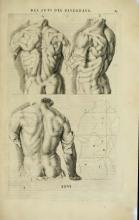
|
The text is a heading from an art book about drawing, titled "Of the Art of Drawing." It includes letters and a Roman numeral representing a figure or section. The page seems to be part of a structured sequence in an art manual. |
| dePas - First Part - Page 63 |
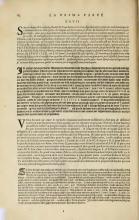
|
The text discusses human anatomy, focusing on proportions in drawing. It provides a practical guide for depicting the body, suggesting the use of simple tools to measure dimensions effectively. |
| dePas - First Part - Page 64 |
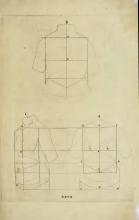
|
This page features two anatomical drawings with construction lines and labels, teaching proportions in art. It corresponds to the book "The First Part of the Light of Painting and Drawing, in the Oval," by Crispijn de Pas from 1670. |
| dePas - First Part - Page 65 |
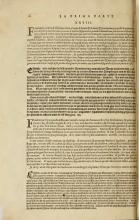
|
The text describes the subtle differences between male and female bodies, emphasizing the adjustments needed when drawing different parts from youth to adulthood. It advises on techniques for drawing such as using charcoal and precise lines, detailing the process to ensure shadows and lights are accurately depicted. The importance of maintaining delicate textures and ensuring they fade smoothly into light is also emphasized. |
| dePas - First Part - Page 66 |

|
The image contains the Roman numeral XXVII, indicating a page or section number in the book. |
| dePas - First Part - Page 67 |

|
SummaryThe page discusses the proportions of children's bodies, both male and female, in different languages. It outlines a method to articulate the limbs of children who have not yet reached full stature by dividing the body into measured sections from head to toe, using guidelines based on anatomical landmarks. The approach focuses on balancing form and length and provides structured ways to align their proportions based on historical measurements and visual references. |
| dePas - First Part - Page 68 |
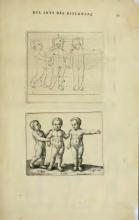
|
The text, titled "On the Art of Drawing," introduces the concept of drawing techniques related to human anatomy. This title connects to the images on the page, which provide visual instruction in drawing proportions and forms. The images illustrate both basic and advanced concepts in figure drawing. |
| dePas - First Part - Page 69 |
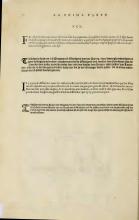
|
The text discusses the physical differences between young boys and girls around the age of three. It points out that girls tend to have narrower shoulders, larger and more elevated bellies, and broader hips compared to boys. These observations are consistent across different languages in the text and note the slight variations based on whether the children are lean or plump. |
| dePas - First Part - Page 70 |
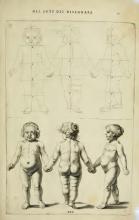
|
The text "DEL ARTE DEL DISEGNARE" translates to "On the Art of Drawing." This is the title of the page, indicating the subject covered in this section of the book. |
| dePas - First Part - Page 71 |
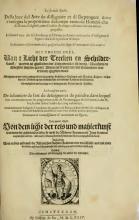
|
The text discusses methods for teaching the proportions of the human body in art, using the concept of five columns as a foundational guide. It details the practices of the Roman Painters' Academy in clothing figures, understanding perspective, and studying the movement of figures. The information is presented in multiple languages, highlighting historical teaching methodologies in art. |
| dePas - First Part - Page 72 |
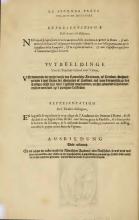
|
The text discusses the proper techniques taught at the Roman Academy and Drawing Schools. It emphasizes the elegance required in posing models, the use of lamplight, and the application of shadows to accurately represent figures on paper. The principles are explained in Italian, Dutch, French, and German, highlighting the universal importance of these techniques in art training. |
| dePas - First Part - Page 73 |
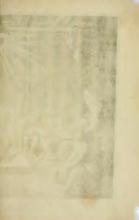
|
|
| dePas - First Part - Page 74 |
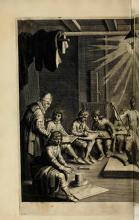
|
|
| dePas - First Part - Page 75 |
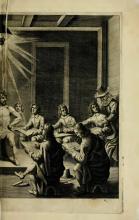
|
|
| dePas - First Part - Page 76 |

|
|
| dePas - First Part - Page 77 |
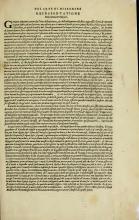
|
The text discusses the revival and evolution of drawing techniques, emphasizing clarity and uniformity. Giovanni Amatori critiques past practices that neglected proportions and highlights the importance of classical study. The work encourages a balance between learned technique and observation of natural life to achieve beauty and harmony in art. |
| dePas - First Part - Page 78 |

|
The document discusses the restoration and teaching of painting and drawing, highlighting the importance of academic practices revived by respected figures like Cimabue and Raphael after a period of decline due to invasions. It emphasizes the role of careful preparation, lighting, and proportion in the art of drawing. The text also underscores the significance of understanding figure modeling and provides guidance on maintaining elegance and strength in artistic depictions. |
| dePas - First Part - Page 79 |

|
The text discusses the tradition of drawing and painting art as practiced by the ancient Greeks and Romans, noting its decline and eventual revival by Italian scholars. It compares this revival to the rekindling of the Latin language through enthusiastic educational efforts. This serves as an introduction to a work focused on drawing from life and nature. |
| dePas - First Part - Page 80 |
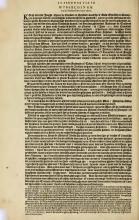
|
The text discusses the history and techniques of drawing and painting, emphasizing the importance of practice and understanding proportions in art. It highlights famous artists like Michelangelo and Raphael as paragons of the craft. The text also stresses the significance of structured education in mastering drawing skills, achieving realistic representations, and encouraging collaborative learning. |
| dePas - First Part - Page 81 |
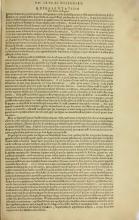
|
The text discusses the historical decline and revival of painting and drawing, with a focus on the Italian contribution through the use of lamplight for shading. It highlights the precision required in drawing, emphasizing proportion, and the importance of systematic training in an academy setting. The text gives advice on setting up a suitable studio and choosing a well-proportioned model for drawing practice. |
| dePas - First Part - Page 82 |
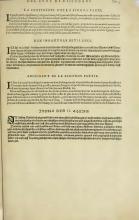
|
The text teaches artistic drawing of figures with correct proportions, using a simple method based on lines or modules. It includes instructions on how to dress these figures using various fabrics and shading techniques modeled after Roman styles. Different styles for drawing men, women, and children are discussed, focusing on their realistic depiction in various poses. |
| dePas - First Part - Page 83 |
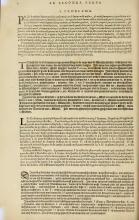
|
The text describes the similarity between human measurements and columns. It discusses using a "module" as a unit to measure parts of the human body, such as dividing the body into seven parts from head to feet. This method allows for understanding proportions and is applicable to both art and construction. |
| dePas - First Part - Page 84 |
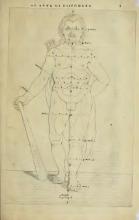
|
The text at the top of the page translates as "The Art of Drawing." The content suggests that this page is part of an educational resource focused on teaching the accurate depiction of human figures in art. It emphasizes learning the correct proportions and measurements needed for drawing. |
| dePas - First Part - Page 85 |
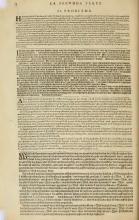
|
The text describes detailed technical instructions for sketching the human form using specific dimensions and proportions. Various languages provide a universal approach to visualizing the human figure, focusing on geometry and proportional methods. The document intends to teach precision in artistic representation, ensuring realistic depictions of human anatomy. |
| dePas - First Part - Page 86 |
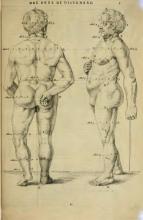
|
The image features two anatomical drawings labeled for instructional purposes related to the art of drawing. It includes stylized letters and measurements to guide the representation of human proportions. This aligns with the book's educational intent on teaching drawing by understanding anatomy. |
| dePas - First Part - Page 87 |
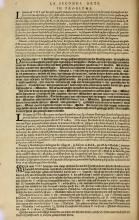
|
The text discusses the proportional similarities between a man with eight heads and the Doric column, suggesting that this proportion is better suited for certain descriptions. It compares this method with the Tuscan style, emphasizing the nobility and propriety of the Doric style for such artistic descriptions. The text uses the concept of 'heads' as a unit of measurement in art. |
| dePas - First Part - Page 88 |
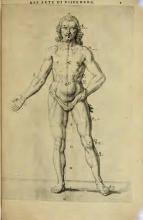
|
The text includes the title "The Art of Drawing" and a list of labeled points (A to S) on an anatomical drawing. The labels are likely used as reference points for anatomical proportions in drawing. |
| dePas - First Part - Page 89 |
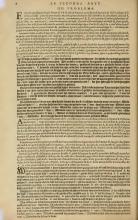
|
The text presents instructions for drawing the human figure using classical proportions. It discusses depicting a person from both the front and back, involving drawing perpendicular lines for accuracy. This text includes translations in Dutch and French, emphasizing the eight-heads technique for human proportions. |
| dePas - First Part - Page 90 |
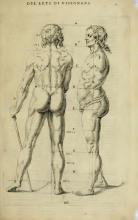
|
The page is a guide on drawing with labeled parts for teaching anatomy and proportions. The annotations correspond to different sections of the human body to assist artists in learning correct proportions. It reflects 17th-century art instruction methods. |
| dePas - First Part - Page 91 |
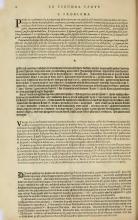
|
The provided text draws a comparison between human proportions and those of Ionic columns, stating both are equally beautiful and dignified. It offers a method to depict a man's posture, using a vertical line split into nine sections to guide the proportional measurements. The instructions include details on aligning body parts with calculated measurements to achieve symmetry and balance, reflecting accuracy and attention in stature, similar in elegance to classic Ionic columns. |
| dePas - First Part - Page 92 |
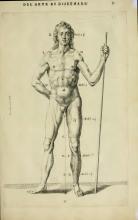
|
The image includes labels in Italian referring to drawing modules with various fractions, focusing on the study of artistic proportions. It serves as an educational tool for understanding human anatomy and proportion in art. This aligns with the book’s purpose of providing drawing instructions related to the human body. |
| dePas - First Part - Page 93 |
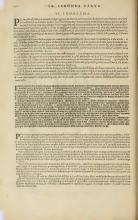
|
The text discusses the method of representing a human figure with nine heads, a concept used to describe proportions in art. It outlines the process of scaling the human body using a perpendicular line divided into nine equal parts, covering both width and height measurements. The instructions guide how to proportionally adjust body parts such as the head, neck, shoulders, hips, knees, and feet, ensuring accurate artistic representation. |
| dePas - First Part - Page 94 |

|
This image is from an art book focused on human anatomy for drawing. It includes labeled modules indicating proportions of the human body, aiding in accurate artistic representation. The image is part of instructional content for artists, highlighting body structures. |
| dePas - First Part - Page 95 |
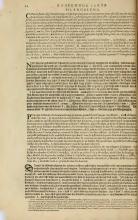
|
The text discusses the artistic representation of statues, focusing on proportions and composition. It explains how to divide the human form into segments using a system called 'Module' to achieve visual harmony. The passage emphasizes the importance of understanding dimensions when depicting human figures. |
| dePas - First Part - Page 96 |

|
The image features a detailed drawing titled 'On the Art of Drawing,' displaying a male figure annotated with modules for study. The figure serves as an artistic reference for understanding human anatomy. These notes appear designed to guide artists in accurately drawing human proportions and muscle structures. |
| dePas - First Part - Page 97 |
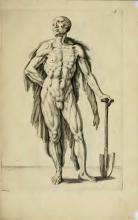
|
|
| dePas - First Part - Page 98 |
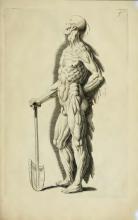
|
|
| dePas - First Part - Page 99 |
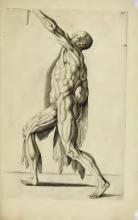
|
The only discernible text is the number "10" in the image, which appears to be a page number. |
| dePas - First Part - Page 100 |
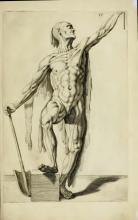
|
|
| dePas - First Part - Page 101 |
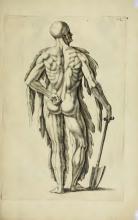
|
The page contains only the number "12" and a detailed anatomical illustration of a male figure from the back holding a spade. The artwork emphasizes transparency in human musculature and bones, illustrating body structure. This is likely a part of a book teaching anatomical drawing techniques. |
| dePas - First Part - Page 102 |
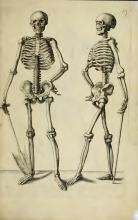
|
|
| dePas - First Part - Page 103 |
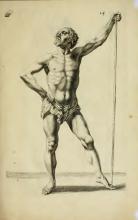
|
The page number 14 is shown, and it features a detailed illustration of a male figure, likely used for teaching anatomy in art. |
| dePas - First Part - Page 104 |
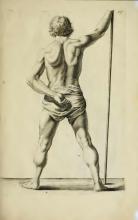
|
The page contains the number "15," likely indicating a page or illustration number. The primary feature of the page is a detailed anatomical drawing of a male figure from behind. |
| dePas - First Part - Page 105 |
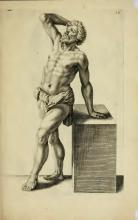
|
The image shows the number "16" and features a detailed illustration of a male figure in a classic artistic pose. The illustration is likely intended for anatomical study and drawing practice, emphasizing muscle detail and body posture. |
| dePas - First Part - Page 106 |
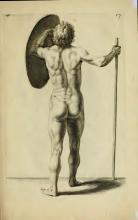
|
The page includes the numeral '17' and features a detailed anatomical drawing of a male figure, showcasing the musculature from a rear view. The drawing is part of a historic book on drawing and painting anatomy. |
| dePas - First Part - Page 107 |
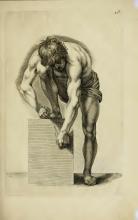
|
|
| dePas - First Part - Page 108 |
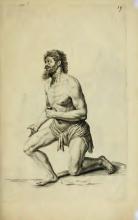
|
The page displays the number '19' and features an anatomical illustration, likely from an art instructional book. This suggests its purpose is to demonstrate human proportions and poses. |
| dePas - First Part - Page 109 |
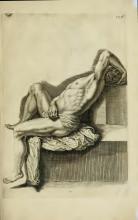
|
The image contains the number "20," possibly indicating a page or diagram number. It is an illustration of the human figure in a detailed anatomical pose from a historic art book. |
| dePas - First Part - Page 110 |
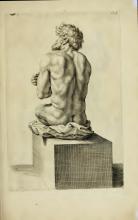
|
The image includes the text 'C1', which likely functions as a reference or label. The engraving depicts a detailed study of a male figure's back, suitable for anatomical education. The artistic style and subject support the book's objective of teaching painting and drawing techniques, particularly in understanding human anatomy. |
| dePas - First Part - Page 111 |
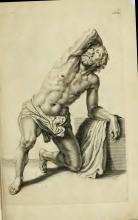
|
|
| dePas - First Part - Page 112 |

|
|
| dePas - First Part - Page 113 |
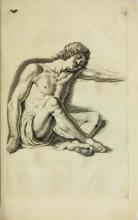
|
This page features an engraving of a seated male figure, focusing on anatomical details. The artwork reflects the style and educational intent of 17th-century art books, likely used for teaching drawing techniques. |
| dePas - First Part - Page 114 |
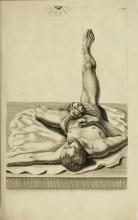
|
|
| dePas - First Part - Page 115 |
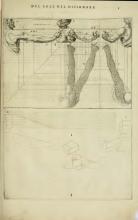
|
The text titled "The Art of Drawing" consists mainly of letters and numeric labels used within illustrated drawings on the page. The focus is on the techniques and proportions for depicting arms and hands in a structured, artistic manner. It demonstrates the practical application of geometry to create realistic human figures in art. |
| dePas - First Part - Page 116 |
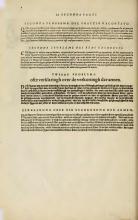
|
The text discusses techniques for drawing arms in foreshortened perspective, specifically focusing on proportions and measurements. Instructions are provided for maintaining accuracy by following specific artistic rules, such as using perpendicular and diagonal lines for reference. The explanation is given in multiple languages including Italian, French, Dutch, and German. |
| dePas - First Part - Page 117 |
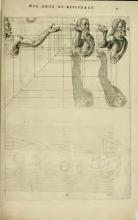
|
The image contains a heading that translates to "Of the Art of Drawing," highlighting a focus on artistic techniques, specifically drawing. |
| dePas - First Part - Page 118 |
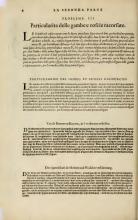
|
The text details techniques for drawing the shortened proportions of legs and thighs using reference lines and shadows. Instructions are provided in Italian, French, Dutch, and German, emphasizing careful consideration of light and perspective. The methods involve marking and intersecting lines to achieve accurate anatomical proportions. |
| dePas - First Part - Page 119 |
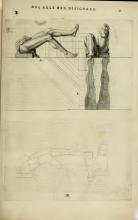
|
The text is titled "Of the Art of Drawing" and seems to introduce a section of a historic book. It accompanies anatomical illustrations to aid understanding of human proportions and drawing techniques. |
| dePas - First Part - Page 120 |
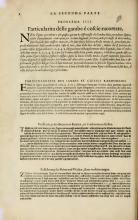
|
The page discusses the specific techniques of drawing shadows on shortened legs and thighs. It explains how these shadows are represented by diagonal lines crossing the figures and how measurements can be checked marked by line A. This instruction is detailed across various languages, emphasizing specific methods to draw the shadows and intersections for clarity. |
| dePas - First Part - Page 121 |
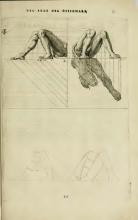
|
The text titled 'On the Art of Drawing' is accompanied by illustrations demonstrating techniques for drawing the human body, focusing on perspective and anatomy. The page number is 4. The illustration provides visual guidance for artists on constructing figures accurately. |
| dePas - First Part - Page 122 |
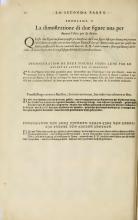
|
The text demonstrates how two figures can be used to show the front and back view of a body. It explains foreshortening of the arms and the use of shadows to create a sense of depth, marked as A and B. The text suggests that these methods adhere to standard drawing techniques to achieve the desired perspective. |
| dePas - First Part - Page 123 |
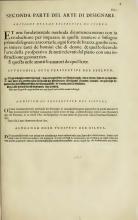
|
The text provides a foundational method for learning how to draw or foreshorten every type of body part according to the rules of perspective. It emphasizes instruction in the geometric art to help artists draw both men and women accurately. The content is aimed at helping art lovers and amateurs improve their skills, using techniques that are scientifically backed by land surveyor's instruction. |
| dePas - First Part - Page 124 |
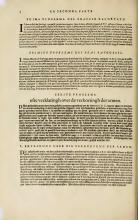
|
The text discusses techniques for drawing foreshortened arms using geometric perspectives and measurements from different views. It emphasizes proportions, shadowing, and the use of perpendicular lines to achieve realistic representations. The explanations include descriptions of how to perceive angles and foreshorten arms effectively in artistic representations. |
| dePas - First Part - Page 125 |

|
The text is the title "On the Art of Drawing," indicating the subject of the page. It is part of a historical art instruction book focusing on techniques for drawing figures. |
| dePas - First Part - Page 126 |
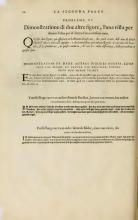
|
The page discusses the method of drawing two figures, one from the front and the other from the back, using a consistent technique. It emphasizes that the arm positioning should follow the same rule to maintain uniformity, ensuring no difference between this and previous illustrations. The instructions are provided in multiple languages for a broader audience. |
| dePas - First Part - Page 127 |
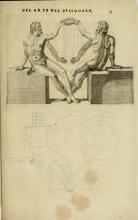
|
The text translates to "On the Art of Drawing," hinting at a treatise focused on illustrating techniques and the principles of drawing. |
| dePas - First Part - Page 128 |
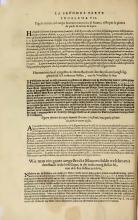
|
This text discusses techniques for drawing the human figure with a focus on foreshortening, a method that creates an illusion of depth by compressing dimensions. It emphasizes observing proportions and shadows to accurately depict figures, especially when viewed from specific angles such as from the front or side. The explanation includes instructions on maintaining proportionality while drawing lines to achieve the desired perspective effect. |
| dePas - First Part - Page 129 |
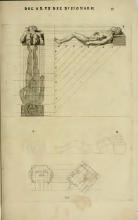
|
The text, in Italian, translates to 'On the Art of Drawing.' The page includes diagrams showcasing techniques for drawing proportions of the human body using grid methods. It serves as an instructional guide for artists in achieving accurate representations of human figures in different positions. |
| dePas - First Part - Page 130 |
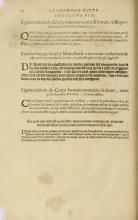
|
The text discusses the depiction of a human body from various perspectives. It emphasizes that the current figure, like the previous one, is viewed from the top of the head for proportional accuracy despite differing viewpoints. The descriptions and proportions remain consistent with earlier depictions, explaining the vantage point as a significant factor in representation. |
| dePas - First Part - Page 131 |
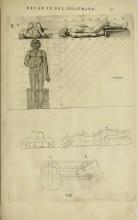
|
The image contains the title "Of the Art of Drawing." It is part of an instructional book on drawing techniques, demonstrating figures with precise guides to aid artists in achieving correct proportions and perspectives. |
| dePas - First Part - Page 132 |

|
The text discusses the method of drawing human figures from unusual perspectives, focusing on proportions, measurements, and shadow depiction. It describes techniques for shortening parts of the body in representation, ensuring that all components are in balance. Observing specific lines and positions helps visualize the figure's proportions accurately. |
| dePas - First Part - Page 133 |
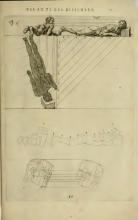
|
The text describes the art of drawing, specifically focusing on using perspective and grids to accurately depict human figures and facial structures. It emphasizes proportional guidelines, labeled with numbers, to aid artists in achieving accurate spatial representation. This instructional text is accompanied by detailed illustrations demonstrating these principles. |
| dePas - First Part - Page 134 |
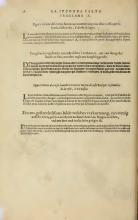
|
The text discusses the technique of foreshortening in drawing the human body, specifically viewing from the top of the head. It explains how lines are used to convert a standard figure into a foreshortened one, focusing on the intersections and perspectives involved. Instructions are repeated in multiple languages on how to achieve this visual effect in art. |
| dePas - First Part - Page 135 |
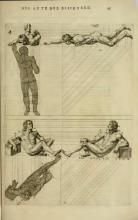
|
The page title translates to "Of the Art of Designing," indicating the focus on teaching principles of design and drawing. The detailed illustrations depict various human body poses with lines and numbers for measurement. These elements suggest a methodical approach to understanding human anatomy for artistic rendering. |
| dePas - First Part - Page 136 |
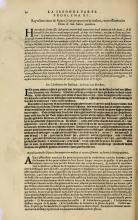
|
The text discusses the representation of figures in art through the use of proportions and measurements, using square blocks as a teaching tool. It explains how these blocks can demonstrate different perspectives and postures of the human form, which is essential for both painters and sculptors. The passage emphasizes the importance of representing living bodies, not just static figures, by using various perspectives and maintaining correct proportions. |
| dePas - First Part - Page 137 |
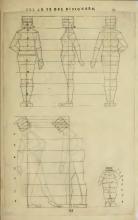
|
The page features diagrams related to the art of designing, specifically focusing on human proportions. It shows structured, geometric drawings of human figures for educational purposes. These illustrations emphasize teaching systematic human anatomy through visual aids. |
| dePas - First Part - Page 138 |
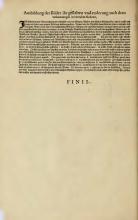
|
The text outlines a workshop's handling of male, female, and child portraits, emphasizing the need for different portrayals for various forms and contexts. It provides guidance on how figures maintain their proportions while differing in styles or usages, with references to specific markings for further illustrations. The discussion includes details on correct visualization, instruction, and adaptation of artistic figures. |
| dePas - First Part - Page 139 |
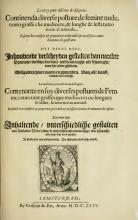
|
This page introduces the third part of a treatise on drawing, focusing on the depiction of various postures of nude women. It emphasizes the importance of accurately capturing different body types, such as plump, average, tall, and slender, in life-like proportions. The text is presented in multiple languages and addresses itself to art lovers and learners in the year 1644. |
| dePas - First Part - Page 140 |
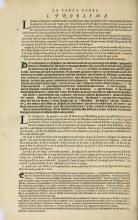
|
The text discusses the proportion of the human body in art, referencing ancient and modern artists, and particularly Albrecht Dürer's work. It talks about measurement techniques to achieve accurate body proportions using modules or units specific to art. The passage aims to explain basic principles of proportion for achieving beauty and perfection in depictions of the human form. |
| dePas - First Part - Page 141 |
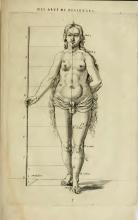
|
The text "Del Arte de Designar" translates to "On the Art of Drawing," indicating a focus on drawing skills. The image accompanies this text to illustrate human anatomy for art education. It offers a visual guide for accurately depicting the human body in art. |
| dePas - First Part - Page 142 |
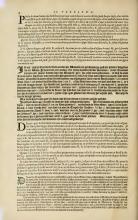
|
The passage provides instructions on depicting the female form with specific measurements and proportions compared to men. Women's shoulders are wider, and details are provided on dividing the body into proportional parts from head to feet. It further elaborates on consistent alignment and outlines the proportions in different languages, focusing on artistic rendering of the human body. |
| dePas - First Part - Page 143 |
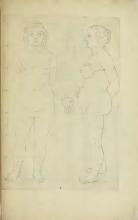
|
|
| dePas - First Part - Page 144 |
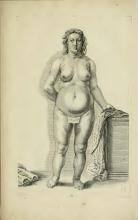
|
The image features a detailed engraving of a female figure standing beside a draped pedestal. It demonstrates human anatomy for instructional purposes in art. The style is typical of 17th-century drawing guides. |
| dePas - First Part - Page 145 |
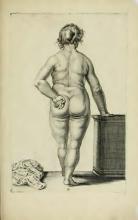
|
|
| dePas - First Part - Page 146 |
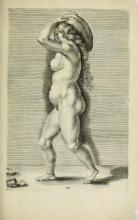
|
The image contains a numeral "III" at the bottom, indicating a page or section number. |
| dePas - First Part - Page 147 |
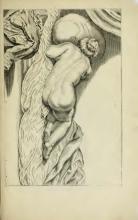
|
The image shows a detailed engraving of a nude figure lying on draped fabric, highlighting artistic anatomy and shading techniques. It aligns with the book's theme of drawing and painting the human figure. |
| dePas - First Part - Page 148 |
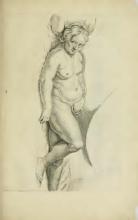
|
The page features a numeral, 'VI,' likely indicating the page number or a section label. It accompanies an illustration of a figure. There is no other text present that provides additional context. |
| dePas - First Part - Page 149 |
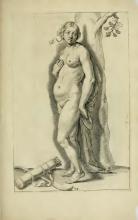
|
A single Roman numeral, VII, is present, marking the engraving as part of a larger sequence. |
| dePas - First Part - Page 150 |
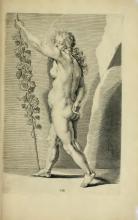
|
The image is labeled with the Roman numeral 'VIII', indicating its sequence in a series. This engraving is part of a historical book showcasing human anatomy for artists. It demonstrates techniques for proportion and detail in drawing. |
| dePas - First Part - Page 151 |

|
The text simply states 'IX', which likely refers to a figure number, as part of a series of illustrations in an art manual. It is part of a larger educational context about drawing and painting techniques. |
| dePas - First Part - Page 152 |

|
|
| dePas - First Part - Page 153 |
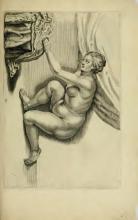
|
The page features the Roman numeral "IX," possibly indicating a chapter or section number. There is no additional text present, focusing instead on the detailed artwork. |
| dePas - First Part - Page 154 |

|
|
| dePas - First Part - Page 155 |
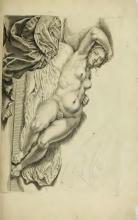
|
|
| dePas - First Part - Page 156 |
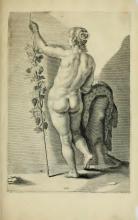
|
The text simply reads 'XIII', indicating the number of the image in a series. |
| dePas - First Part - Page 157 |
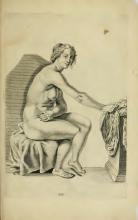
|
The page includes the number 'XIV' and features a detailed engraving of a nude figure. It is part of a book teaching drawing techniques, focusing on the portrayal of the human body. The image is meant to provide reference for studying anatomy. |
| dePas - First Part - Page 158 |
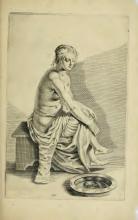
|
|
| dePas - First Part - Page 159 |

|
This page contains the plate number XVII from an illustrated series. There is no further text to summarize. |
| dePas - First Part - Page 160 |
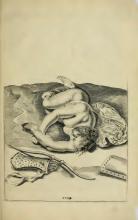
|
The only text on the page is the roman numeral 'XVII', indicating the page number or illustration number. |
| dePas - First Part - Page 161 |
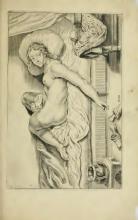
|
The only discernable text in the image is "XIII," which likely indicates the page or illustration number. |
| dePas - First Part - Page 162 |
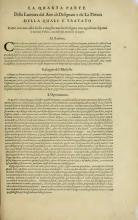
|
This text, addressing the art of design and painting, focuses on dressing figures in garments using a wooden model. It explains the use of a wooden mannequin as a practical tool to study proportions and posed garments in art, avoiding the fatigue of live models. The manuscript also outlines the importance of understanding light, shadow, and materials to accurately design clothing drapery in portraits and historical compositions. |
| dePas - First Part - Page 163 |
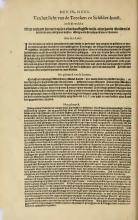
|
This is a continuation from previous sections aiming to educate on the precise depiction of human figures. It discusses necessary techniques and tools for achieving accurate proportions, suggesting methods to replicate Italian Masters' accuracy. The text stresses the importance of careful painting to achieve realistic models using various tools and measurements. |
| dePas - First Part - Page 164 |
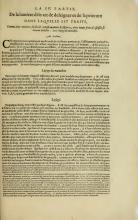
|
The text is a section about the techniques of dressing and posing figures in art, using mannequins to study draperies. It instructs on the benefits of using a wooden model, or mannequin, to represent clothing and dynamic poses in a stable manner for art and includes advice on proportion and the depiction of figures. The content aims to guide artists in enhancing their work by utilizing mannequins for posed studies. |
| dePas - First Part - Page 165 |
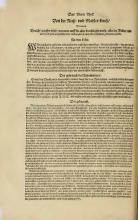
|
The text describes the artistic techniques used in the depiction of human figures, focusing on proportions and the use of manikins. It provides guidance for artists on how to achieve realism and how various nations have adopted these methodologies. The use of perspective and lighting is highlighted to make figures appear more lifelike. |
| dePas - First Part - Page 166 |
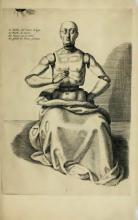
|
The text provides different translations for a wooden mannequin used for artistic studies. It refers to the model as both a machine and a representation of the human form. This mannequin serves as a foundational tool for understanding human anatomy in art. |
| dePas - First Part - Page 167 |
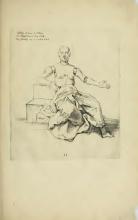
|
The image contains three lines of text instructing to apply certain artistic techniques, involving the use of a hat with a specific tool and shading supported by an unspecified element. The text seems to guide specific drawing actions for the depicted figure. |
| dePas - First Part - Page 168 |
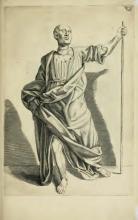
|
This is an image from a historical art book, showing detailed human anatomy. The illustration serves as an educational tool in drawing and painting for understanding posture and drapery. |
| dePas - First Part - Page 169 |

|
The page features an illustration of three robed figures in classical poses, showcasing a study of fabric and posture. The image aligns with the instructional content of the book, which aims to teach artists about drawing the human form. This reflects the 17th-century emphasis on detailed and dynamic representation in art. |
| dePas - First Part - Page 170 |
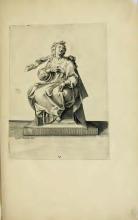
|
The text identifies the image as the work of Joseph Arginas, with the Roman numeral 'V' possibly indicating a page or section number. The artwork is part of a detailed illustration, potentially related to artistic guidance in the book. |
| dePas - First Part - Page 171 |
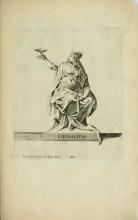
|
The text mentions 'Generosity' as the focal theme of the scene, set in a classical style from Rome by Joseph Arpino. The image features a seated figure personifying the virtue of generosity, marked with a numeral VI. |
| dePas - First Part - Page 172 |
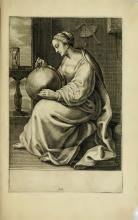
|
|
| dePas - First Part - Page 173 |
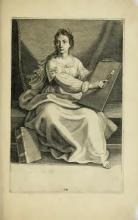
|
The page features Roman numeral VIII, suggesting its place in the sequence of a book. It contains an illustration of a woman actively engaged in drawing or art, reflecting the book's theme of instructing readers in artistic techniques. |
| dePas - First Part - Page 174 |
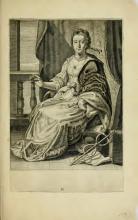
|
The page is marked with the number IX. An engraving of a woman in formal attire is the central illustration. |
| dePas - First Part - Page 175 |
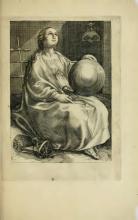
|
The page includes the Roman numeral 'X' at the bottom. The focus is on the engraving of a woman holding a sphere, with additional objects suggesting a scientific or artistic theme. |
| dePas - First Part - Page 176 |
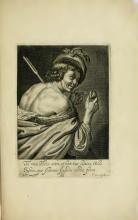
|
The text is a poetic tribute to "Flora," likening her eyes to the Sun and describing her ability to warm cold hearts. This suggests admiration for her beauty and spirit. |
| dePas - First Part - Page 177 |
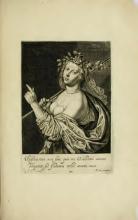
|
The text is a poetic expression, describing a person who feels touched by the love of Coisdonis, comparing it to flames in a beloved city. It reflects a romantic or passionate sentiment that emphasizes the connection felt despite rustic surroundings. |
| dePas - First Part - Page 178 |

|
The engraving portrays Mars, the Roman god of war, accompanied by a cherub. The text questions why Mars, known as the father of the Aeneads and connected to Priamea, would take up arms contrary to his prior peaceable engagements. It credits the painting to I. Hondius and the publication to C. de Pas. |
| dePas - First Part - Page 179 |
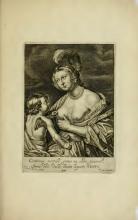
|
The text refers to Venus, who is depicted as protecting the human race by providing them with weapons and sweet liquid, likely symbolizing life and sustenance. The image and text capture the divine protective and nurturing role often linked to Venus in classical mythology. |
| dePas - First Part - Page 180 |
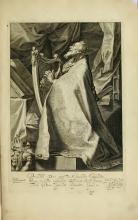
|
The image includes a passage from Psalm 48, urging praise for God as the King of all the earth, accompanied by an engraving illustrating a man playing the harp, emphasizing the theme of musical worship. |
| dePas - First Part - Page 181 |
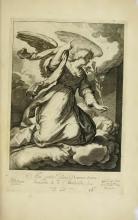
|
The text is a Latin phrase, "Here full of grace, the Lord is with you: blessed are you among women." It is a religious phrase often associated with Mary, the mother of Jesus. The artwork complements the religious and spiritual theme with an angelic figure. |
| dePas - First Part - Page 182 |
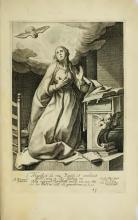
|
The text is a passage from the Gospel of Luke, known as the Magnificat, expressing praise and joy in God's saving grace and humility. It notes the humility of the servant, implying a biblical or saintly figure. The engraving is credited to A Bloemaert and was created by Crispijn de Passe. |
| dePas - First Part - Page 183 |
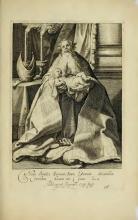
|
The text is a Latin excerpt from the biblical 'Nunc dimittis,' where the speaker is ready to depart in peace according to God's word, referencing the Gospel of Luke. The artwork was designed by F. Bloemaert and executed and published by Crispijn de Passe. |
| dePas - First Part - Page 184 |
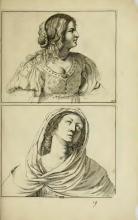
|
|
| dePas - First Part - Page 185 |

|
The page features minimal text, simply showing the identifiers "NN C20." It primarily consists of detailed engravings of two women. Their hairstyles and attire are typical of the 17th century, focusing on the intricacies of texture and profile. |
| dePas - First Part - Page 186 |
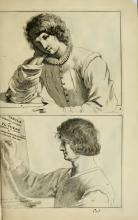
|
The text refers to tables drawn by Joseph, described as merciful, with some direct references to Jacomo Palma. It implies a connection between the creator and the artistic depictions. |
| dePas - First Part - Page 187 |
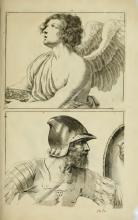
|
|
| dePas - First Part - Page 188 |
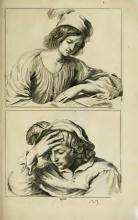
|
This page contains two detailed engravings titled "Images." The engravings feature young people in contemplative poses. The artwork highlights expression and detail typical of historic drawing styles. |
| dePas - First Part - Page 189 |
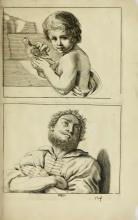
|
|
| dePas - First Part - Page 190 |
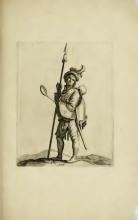
|
The text consists of the Roman numeral XXV, indicating a page or figure number. It translates to 25 in English. |
| dePas - First Part - Page 191 |
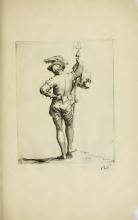
|
The image includes a small number "26," possibly referencing a page or figure number. The main focus of the page is the illustrated drawing. |
| dePas - First Part - Page 192 |

|
The single numerals "XXVII" are the only text present, suggesting the 27th figure or page of the book. The image itself is illustrative and provides insight into the historical style and teaching methods of the book. The page is likely focused on human figure study or art anatomy practice. |
| dePas - First Part - Page 193 |
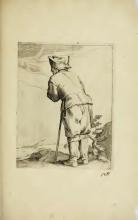
|
The image features the number "12" possibly indicating a page or illustration number. No additional explanatory text is present. |
| dePas - First Part - Page 194 |

|
|
| dePas - First Part - Page 195 |
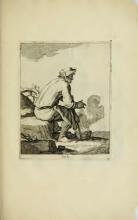
|
The page features the Roman numeral "XXX," indicating page or figure number thirty. The content is primarily visual, showcasing a detailed illustration related to art and anatomy. |
| dePas - First Part - Page 196 |
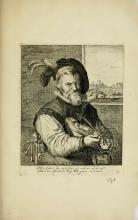
|
The text is a poetic inscription accompanying an illustration. It mentions that the speaker's strings, likely of a musical instrument, are well maintained, and that with help, everything goes best. The text hints at both practical and metaphorical assistance. |
| dePas - First Part - Page 197 |

|
The image contains Dutch text describing graceful figures of women depicted by A. Blomaert and published by F. de Wit. It aligns with the historical context of illustrating human figures as outlined in the book's theme. |
| dePas - First Part - Page 198 |
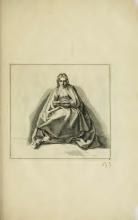
|
The number 53 is visible on the page. The presence of this number suggests a possible page reference or chapter indicator in the context of the book. |
| dePas - First Part - Page 199 |
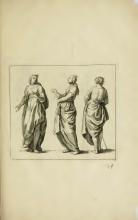
|
The image is labeled with the number '34'. Three female figures are depicted displaying different poses, likely illustrating drawing techniques related to body posture and clothing folds. |
| dePas - First Part - Page 200 |

|
The page displays an illustration of three women in classical poses, intended as a study of human form and drapery. The only textual content is the number "35." This aligns with the book's focus on teaching drawing techniques involving the human figure. |
| dePas - First Part - Page 201 |
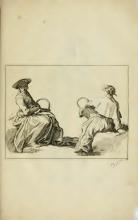
|
|
| dePas - First Part - Page 202 |
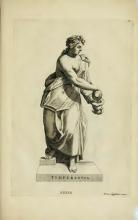
|
The illustration depicts "Temperance," emphasizing harmony and self-restraint with classic elegance. Accompanying text credits designer Roma Langfranco and indicates the illustration's sequence number as 37. The engraving style highlights classical aesthetic values in art. |
| dePas - First Part - Page 203 |

|
The text identifies the illustration as drawn by Giovanni Lanfranco in Rome, depicting a theme of majesty. The inscription 'MAIESTAS' highlights the subject’s grand and authoritative nature. The inclusion of Roman numerals suggests an organized series or collection related to art or anatomy from the period described in the book's context. |
| dePas - First Part - Page 204 |
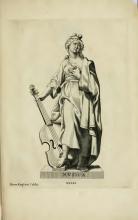
|
The text includes a reference to Lanfranc, likely indicating the creator of the illustration. It marks the page number as thirty-nine with Roman numerals. |
| dePas - First Part - Page 205 |
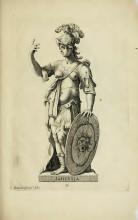
|
The engraving features a figure symbolizing wisdom, inscribed with 'SAPIENTIA.' It was drawn by Lanfranco in Rome and is labeled as the 40th plate in the series. The figure wears armor and holds a shield, indicating a possible representation of the goddess Athena. |
| dePas - First Part - Page 206 |
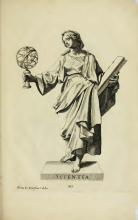
|
The text credits the artwork to the artist Io. Ianfran, who drew it in Rome. It features the word 'SCIENCE,' and the number '42,' possibly indicating a plate or page number in the book context. The illustration is allegorical, depicting the concept of Science through classical symbolism. |
| dePas - First Part - Page 207 |
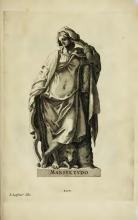
|
The text identifies the image as depicting "Gentleness" (Mansuetudo), created by artist Io. Lanfranco. It is numbered as plate 42. |
| dePas - First Part - Page 208 |
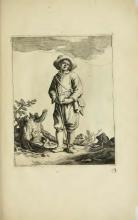
|
|
| dePas - First Part - Page 209 |
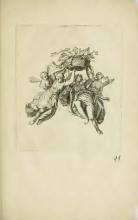
|
The page features an intricate engraving of three allegorical figures holding a basket with flowers, likely representing themes relevant to art and enlightenment. The page is numbered 44 and aligns with the book's focus on painting and drawing. |
| dePas - First Part - Page 210 |
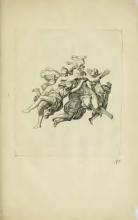
|
The page includes the number '15', indicating its position in the book. It also contains a detailed illustration of mythological figures. This reflects the book's focus on artistic anatomy and drawing. |
| dePas - First Part - Page 211 |

|
The page shows the number '76' and features an illustration of a man standing with a staff, created in a line work style. This appears to be part of a book on artistic techniques. |
| dePas - First Part - Page 212 |
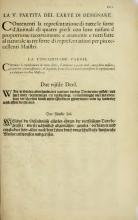
|
The text introduces the fifth part of a treatise on the representation of four-legged animals in art. It discusses the depiction of these animals with precise measurements, proportions, and foreshortening techniques, crafted by various expert artists. The emphasis is on naturalistic representation through the skills of multiple masters. |
| dePas - First Part - Page 213 |

|
This section discusses the method of drawing horses using geometric principles, specifically with the use of compass and grids. It details dividing a square into nine parts and using these divisions to ensure proportional accuracy. The text provides specific instructions on how to place and proportion different parts of the horse, including the head. |
| dePas - First Part - Page 214 |
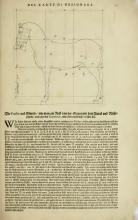
|
The text describes a method for drawing a horse from the side using a compass and straightedge, following geometric principles. It provides detailed instructions on dividing a rectangle into nine equal sections for proportioning the horse. The guide includes specific dimensions and corrections for any alignment errors using geometry-related techniques. |
| dePas - First Part - Page 215 |

|
This text provides detailed instructions on drawing horses in perspective. It explains the geometric principles and techniques necessary for depicting a horse from various angles, specifically from the front and rear. The instructions include creating rectangles and arranging squares to guide the proportions and orientation of the horse's features. |
| dePas - First Part - Page 216 |
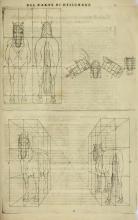
|
The text is a title in Italian which translates to "On the Art of Drawing." The page features a detailed exploration of techniques for drawing horses using a grid system to enhance accuracy and proportion. |
| dePas - First Part - Page 217 |
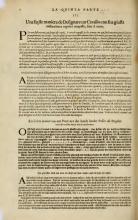
|
The text provides instructions for drawing a horse with accurate proportions using freehand techniques, without relying on tools like a compass or measuring devices. It emphasizes memorizing proportions and using geometric shapes to guide the drawing process. This method is aimed at artists drawing from nature, highlighting creativity and efficiency. |
| dePas - First Part - Page 218 |
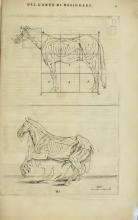
|
The text is the title of a section, 'On the Art of Drawing.' It prefaces detailed illustrations that aim to teach drawing techniques by studying the anatomy of horses. The page is from a historic book dedicated to artistic education. |
| dePas - First Part - Page 219 |

|
The text discusses the challenge of drawing horses accurately, emphasizing the importance of understanding anatomy. It warns against focusing too much on the external appearance and encourages using anatomical studies for realistic depiction. Furthermore, it suggests that the muscles of horses should be observed and memorized for better representation in art. |
| dePas - First Part - Page 220 |
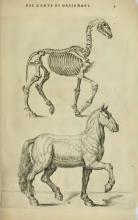
|
The text translates as "On the Art of Drawing," indicating the page is from a book about drawing techniques. It likely introduces the topic of drawing, emphasizing the artistic practice of capturing subjects. This aligns with the detailed illustrative content typical of instructional art books. |
| dePas - First Part - Page 221 |
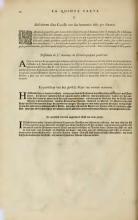
|
This page discusses how to accurately depict a horse's anatomy, emphasizing the importance of understanding and representing various body parts such as muscles, nerves, and facial features. It provides descriptions for viewing the horse both from the side and front, detailing the artistic skills required to capture natural grace. Separate emphasis is on portraying the legs and feet to highlight anatomical and aesthetic elements. |
| dePas - First Part - Page 222 |
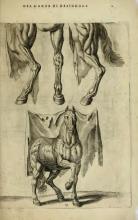
|
The text translates to 'Of the Art of Designing', suggesting a chapter or section focused on the principles or techniques of art design. This context fits within a broader instructional theme common in historical drawing manuals, likely exploring aspects such as anatomy, proportion, or technique. |
| dePas - First Part - Page 223 |

|
The text describes the anatomy of a horse from the rear view in various languages, emphasizing the visibility of muscles and nerves. It explains the mobility and variability of certain parts, marked as A and B, particularly during walking. The descriptions mention the extension and contraction of muscles and the addition of details such as feet and legs for a comprehensive understanding of horse anatomy. |
| dePas - First Part - Page 224 |
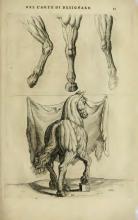
|
This page, titled 'On the Art of Drawing,' appears to introduce a section focusing on the techniques of drawing, possibly linking to animal anatomy or artistic principles. |
| dePas - First Part - Page 225 |
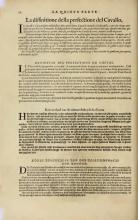
|
The text elaborates on the aesthetic and structural features that define the beauty of a parade horse. It offers guidance for portraying horses artistically, emphasizing proportions, stance, and features like the head, eyes, and mane. The descriptions underscore how horses, alongside humans, represent perfection in beauty among animals. |
| dePas - First Part - Page 226 |

|
The text is the title of a section about drawing techniques. Specifically, it refers to the art of drawing. The accompanying images likely serve as a practical demonstration of the techniques described in the text. |
| dePas - First Part - Page 227 |
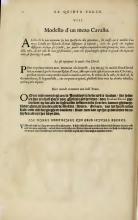
|
The text discusses a model of half a horse drawn by Rolando Zavarì. It aims to teach youth how to better understand and represent horse anatomy, such as muscles and veins, through larger illustrations. Different languages on the page repeat similar instructions emphasizing how larger depictions help reveal subtle anatomical details. |
| dePas - First Part - Page 228 |
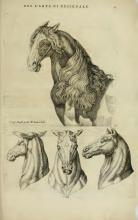
|
The text is titled "The Art of Drawing" and attributes the illustrations to painter R. Saurii. It introduces Plate VIII, likely part of a series illustrating different aspects of drawing. |
| dePas - First Part - Page 229 |
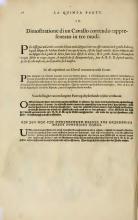
|
The document provides guidance on drawing a running horse in three different descriptions across Italian, French, Dutch, and German. It emphasizes the observation of the horse’s leg positions and the prominence of certain muscles on the body, referencing specific areas like the back, shoulders, and neck. The text concludes that practical experience is crucial for mastering the technique. |
| dePas - First Part - Page 230 |
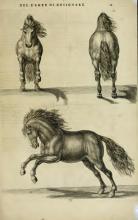
|
This page is titled 'On the Art of Drawing.' It likely serves as an instructional piece on drawing techniques, particularly focusing on depicting animals such as horses from various angles. |
| dePas - First Part - Page 231 |
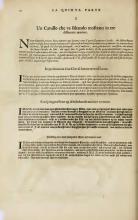
|
The text discusses techniques for illustrating a horse in motion, focusing on the visibility and position of the muscles during a jump. It describes how to position a horse's body parts for an effective depiction, with the muscles marked for clarity. The content is written in Italian, French, Dutch, and German, reflecting a comprehensive approach to art education regarding muscle movement and structure in dynamic poses. |
| dePas - First Part - Page 232 |
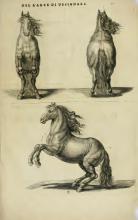
|
The text is a heading in Italian, which translates to 'On the Art of Drawing.' It accompanies detailed anatomical illustrations that depict horses from different angles, meant to teach or demonstrate drawing techniques. |
| dePas - First Part - Page 233 |
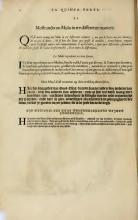
|
The page discusses the depiction of mules in three orientations: side, front, and back. It highlights how mules, while bulkier than horses, share similar proportions, with the primary differences being in their heavier build and large ears. The text is presented in multiple languages, providing detailed comparisons and explanations on measuring and representing mules artistically. |
| dePas - First Part - Page 234 |
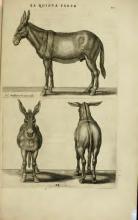
|
This page is titled "The Fifth Part" and includes illustrations of a donkey. The artist and draftsman are mentioned as S.C. Majii and R.S. aurii, respectively. The page number 11 is also indicated. |
| dePas - First Part - Page 235 |
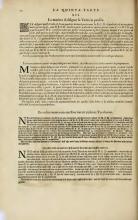
|
The text provides a method for drawing a cow in profile and from various angles by dividing a square into smaller measured parts. It describes specific measurements for different sections like the head, belly, and legs, employing similar techniques used for depicting horses. The technique emphasizes balancing proportions and conveys a sense of realistic motion. |
| dePas - First Part - Page 236 |
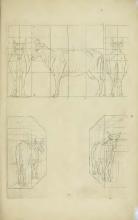
|
|
| dePas - First Part - Page 237 |
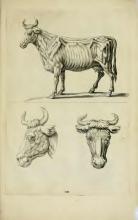
|
The page is labeled "XIII" and features detailed anatomical drawings of a cow from different angles. There is no additional text present. |
| dePas - First Part - Page 238 |
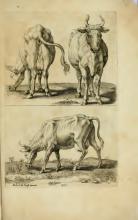
|
|
| dePas - First Part - Page 239 |
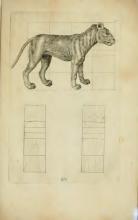
|
The page is marked with the Roman numeral 'XV.' There is no additional text content beyond this heading. |
| dePas - First Part - Page 240 |
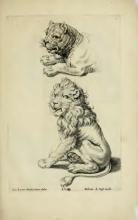
|
The text identifies Roelandt Savery as the original artist who drew the lions, while Robertus de Voge created the engravings. It highlights the contribution of both individuals in crafting the detailed illustrations. The images are educational engravings meant to study animal form and expression. |
| dePas - First Part - Page 241 |
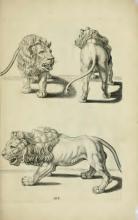
|
The text below the images simply reads 'XVII.' which is a numeral indicating the plate number of the illustrations. |
| dePas - First Part - Page 242 |
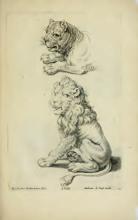
|
The text credits Roelandt Savery as the artist who drew the images and Robertus de Vries as the engraver who created the prints. These names often appear in historical art documents indicating a collaborative artwork. The page likely originates from a book on drawing or art from the 17th century. |
| dePas - First Part - Page 243 |
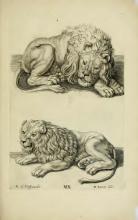
|
The page includes engravings of lions, created by R. de Vorst and R. Savery. The Roman numeral XIX is present. It emphasizes the artists' attention to detail and anatomy. |
| dePas - First Part - Page 244 |
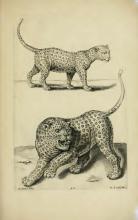
|
The text in the image credits R. Sauey for drawing and Ro. de Voust for sculpting or engraving the images. There is no other detailed textual content provided in this image. |
| dePas - First Part - Page 245 |
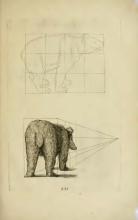
|
The page displays two drawings of a bear, one from the side with a grid and one from the rear with perspective lines. These are likely educational illustrations for drawing animals. |
| dePas - First Part - Page 246 |
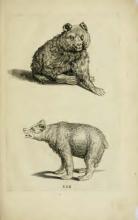
|
This page includes the Roman numeral "XXII". It likely indicates a sequence or reference within the book. |
| dePas - First Part - Page 247 |
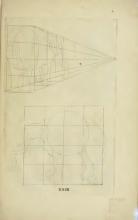
|
The page from the book contains drawings showing geometric and perspective studies, including a perspective cone and a grid with an animal outline. The text only includes the Roman numeral 'XXIII.' |
| dePas - First Part - Page 248 |
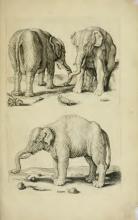
|
The text "XXIIII" likely indicates a page or plate number. The image includes detailed engravings of elephants. |
| dePas - First Part - Page 249 |
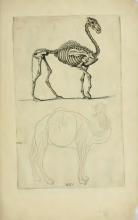
|
The page shows the number twenty-five (XXV), with a detailed anatomical illustration of an animal, likely a camel. The illustrations serve as a study of the animal's skeletal structure and general outline, reflecting the book's focus on art and anatomy. |
| dePas - First Part - Page 250 |
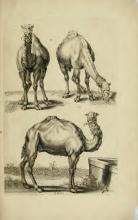
|
This page has the number '26' in Roman numerals (XXVI). There is no additional textual information. |
| dePas - First Part - Page 251 |
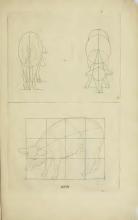
|
This image includes geometric representations and proportions of cows. It is part of a historical art instruction book focused on teaching artists how to depict animals accurately. Roman numeral XXVII indicates the page number. |
| dePas - First Part - Page 252 |
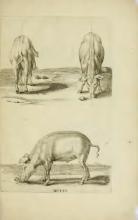
|
The page number in Roman numerals "XXVIII" is present, indicating this is page 28. |
| dePas - First Part - Page 253 |
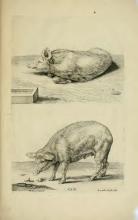
|
The excerpt contains the Roman numeral "..XXIX" which is likely indicating the page or illustration number, without additional text. |
| dePas - First Part - Page 254 |
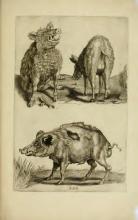
|
This page contains the Roman numeral "XXX" without additional text. |
| dePas - First Part - Page 255 |
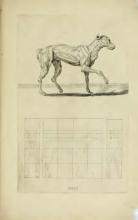
|
The page includes a numeral '31' written in Roman numerals. It appears to be a page identifier in the context of the book. |
| dePas - First Part - Page 256 |

|
The page displays the Roman numeral "XXXII," indicating the page number 32. This is accompanied by detailed illustrations of a dog in different poses. These images are characteristic of the 17th-century artistic focus on anatomy and form. |
| dePas - First Part - Page 257 |
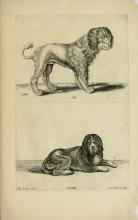
|
This page contains engravings of two dogs by artists R. Savery and Ro. de Vorest. The text identifies the artists and the plate number 33. The dogs are portrayed with detailed artistic engravings. |
| dePas - First Part - Page 258 |
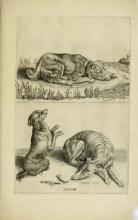
|
The page displays two detailed engravings of dogs in natural poses. It represents the number 34 in Roman numerals. These illustrations are part of a historic book featuring artistic techniques. |
| dePas - First Part - Page 259 |
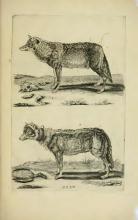
|
The text simply contains the Roman numerals "XX XV," which could refer to a page number or an illustration reference within the book. |
| dePas - First Part - Page 260 |
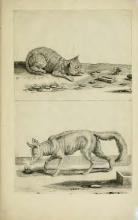
|
The only discernible text is "XXXVI," which might indicate a page or figure number. The main content is visual, consisting of detailed animal illustrations. |
| dePas - First Part - Page 261 |
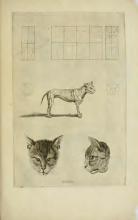
|
Text on the page is largely numeric, representing a page number or figure label 'XXXVII'. The focus is on illustrations for artistic study. |
| dePas - First Part - Page 262 |
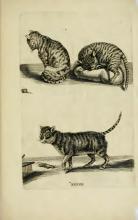
|
The image contains the Roman numeral "XXXVIII," indicating a page number or plate number. There is no other text present. |
| dePas - First Part - Page 263 |
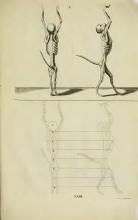
|
The image contains anatomical illustrations showing skeletal figures in various poses with minimal text present. The page appears to be from an instructional guide related to drawing or understanding human anatomy, aiding in artistic representation. |
| dePas - First Part - Page 264 |
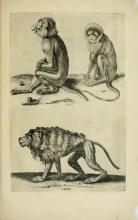
|
The text "XXXX" appears below a series of animal engravings on the page. |
| dePas - First Part - Page 265 |
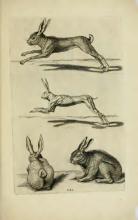
|
The page predominantly features illustrations of rabbits in various poses, possibly intended for anatomical study. The rabbits are depicted in motion and at rest, showcasing musculature and form. The images serve as instructional aids for understanding animal anatomy. |
| dePas - First Part - Page 266 |
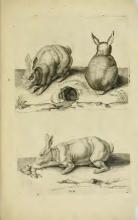
|
The page number is indicated as 42. There are no additional texts apart from this numbering. |
| dePas - First Part - Page 267 |
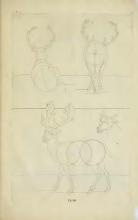
|
The page features geometric line drawings showing different poses of deer. These instructional illustrations likely serve as guides to understanding proportions and anatomy in drawing. The number 'XLIII' indicates this is possibly part of a series or sequence. |
| dePas - First Part - Page 268 |
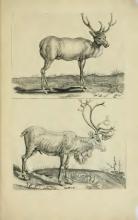
|
This text only contains the Roman numeral 'XLIV', which corresponds to the number 44. |
| dePas - First Part - Page 269 |
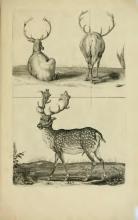
|
|
| dePas - First Part - Page 270 |
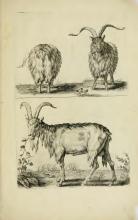
|
The text in the image is simply the Roman numeral 'XLVI', which translates to the number 46 in English, indicating a possible page or figure number in the book. |
| dePas - First Part - Page 271 |
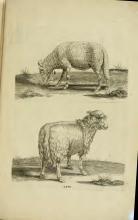
|
The page features engravings of sheep, with a label indicating '67'. |
| dePas - First Part - Page 272 |
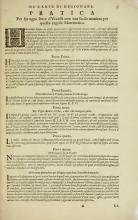
|
The document provides instructions on how to geometrically draw birds with a focus on maintaining correct proportions. Different methods are outlined for drawing various types of birds, such as those with long necks, swans, ducks, geese, and turkeys, using examples like circles and egg shapes. It also discusses techniques for depicting birds naturally, whether alive or dead, and emphasizes practice and experimentation in art. |
| dePas - First Part - Page 273 |

|
This text is an instructional guide on drawing various types of birds. It discusses the geometric shapes used to represent different bird forms and offers specific techniques for sketching birds like swans, ducks, and roosters. The text emphasizes the importance of proportion, observation of nature, and practical methods for achieving accurate bird depictions. |
| dePas - First Part - Page 274 |
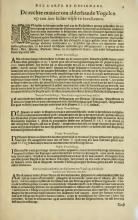
|
This page discusses techniques for drawing birds accurately and easily. It provides various methods and presentations for portraying different types of birds, focusing on key characteristics such as posture, arcs, lines, and details. The text emphasizes understanding birds' natural forms and complexities for more lifelike art. |
| dePas - First Part - Page 275 |
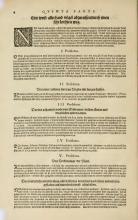
|
The text provides guidance on drawing birds by illustrating proportional techniques. It offers general rules for capturing forms and outlines types of birds such as Swans and Peacocks, focusing on elegance and decoration. The work emphasizes natural forms and artistic interpretation. |
| dePas - First Part - Page 276 |
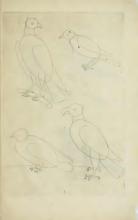
|
|
| dePas - First Part - Page 277 |
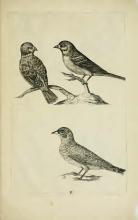
|
This is Page II, which features illustrations of birds. These engravings could serve as examples of detailed artistic techniques. |
| dePas - First Part - Page 278 |
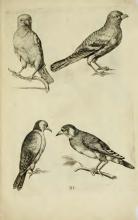
|
The text simply reads 'III', indicating a page or plate number. |
| dePas - First Part - Page 279 |
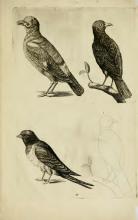
|
The page is numbered 'IV' and contains detailed illustrations of birds. These images are likely part of a historical art instruction manual. |
| dePas - First Part - Page 280 |
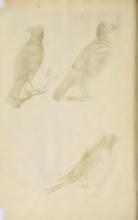
|
|
| dePas - First Part - Page 281 |
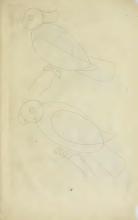
|
|
| dePas - First Part - Page 282 |
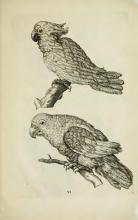
|
The text merely indicates 'VI,' suggesting a plate number. The focus of the page is on the detailed images of two parrots. It is part of a larger work on drawing in 'The First Part of the Light of Painting and Drawing' published in 1670. |
| dePas - First Part - Page 283 |
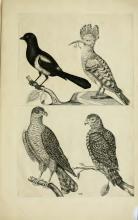
|
|
| dePas - First Part - Page 284 |
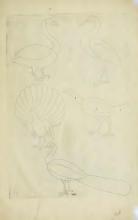
|
The page contains images of birds made with dotted outlines, likely used to teach drawing skills. |
| dePas - First Part - Page 285 |
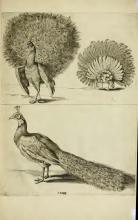
|
The page is from a historic book and contains the Roman numeral 'XCIX,' meaning 99. The image shows detailed engravings of peacocks with their tails fanned out, illustrating the text's discussion of drawing techniques. This complements the book's teaching on depicting parts of the body and nature. |
| dePas - First Part - Page 286 |
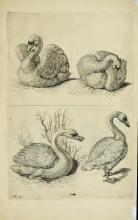
|
The text on the image is the Roman numeral XIII, indicating a page or chapter number. |
| dePas - First Part - Page 287 |
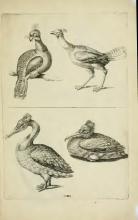
|
|
| dePas - First Part - Page 288 |
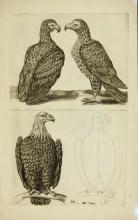
|
The text on the page is simply the Roman numeral 'XII', likely indicating the plate number in the book. |
| dePas - First Part - Page 289 |
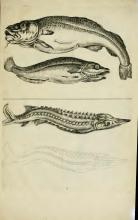
|
|
| dePas - First Part - Page 290 |

|
|
| dePas - First Part - Page 291 |
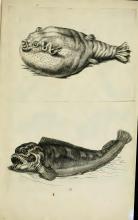
|
|
| dePas - First Part - Page 292 |
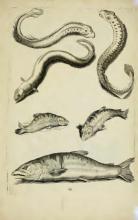
|
The image contains the Roman numeral "IIII." This might indicate the page number of the book from which the illustration is taken. |
| dePas - First Part - Page 293 |
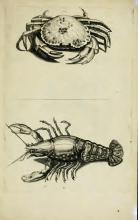
|
The page includes illustrations of a crab and a lobster, labeled with the letter 'V'. These detailed engravings were used for artistic and educational purposes, reflecting the style of the 1670s. |
| dePas - First Part - Page 294 |
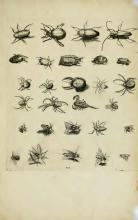
|
The image contains the Roman numeral 'VI', and features detailed illustrations of various insects and arachnids. These illustrations are likely part of an educational section in a book about drawing, showcasing examples for study. It reflects the artistic focus on natural subjects from the era when the book was published. |
COPYRIGHT © 2025 STUDY DRAWING. ALL RIGHTS RESERVED.